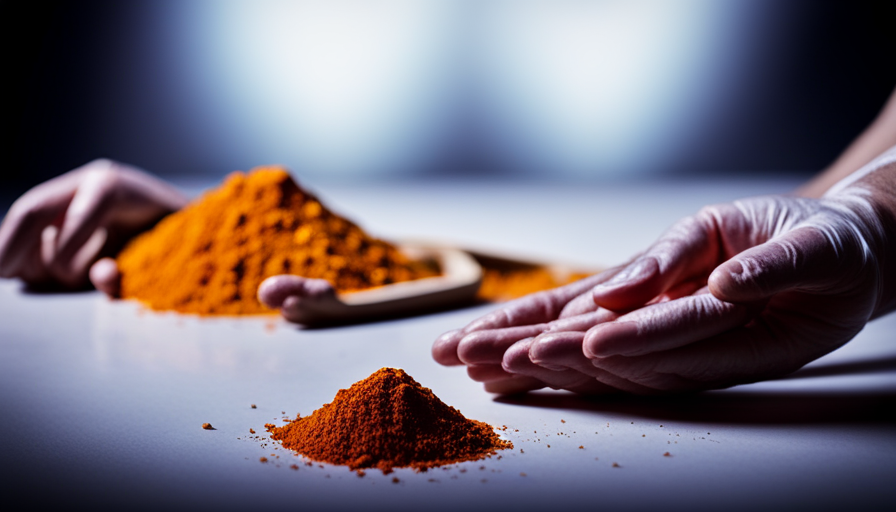Do you enjoy drinking turmeric tea but have trouble straining it correctly? Straining your turmeric tea is crucial for a seamless and satisfying drinking experience.
In this article, we will guide you through the process of straining both fresh and powdered turmeric tea, as well as provide tips and suggestions to help you perfect your technique.
First, let’s discuss the types of strainers available. There are various options such as mesh strainers, tea balls, and cheesecloth. Each type has its own advantages and disadvantages, and choosing the right one depends on your personal preference and the type of tea you are straining.
No matter which type you choose, the key is to ensure that it is fine enough to capture any small particles and produce a clear and smooth liquid. Let’s dive in and learn how to strain turmeric tea like a pro!
Key Takeaways
- Straining turmeric tea is important for a smooth and enjoyable drinking experience.
- Choosing the right strainer size and material is crucial for ease of use and personal preferences.
- Fine enough strainer is key to capture small particles and produce a clear liquid.
- Properly straining turmeric tea enhances its benefits, including anti-inflammatory and antioxidant properties, digestive aid, immune booster, and brain health.
Types of Strainers
When it comes to straining your turmeric tea, there are a few different options to choose from. Mesh strainers are a popular choice, allowing you to easily strain out any chunks or bits of spice.
Tea infusers are great for loose leaf teas, while cheesecloth and coffee filters are perfect for finer straining needs. Depending on your preferences and the type of tea you’re making, each of these options can provide a clean and delicious cup of turmeric tea.
Mesh Strainers
To strain your turmeric tea effectively using a mesh strainer, you’ll want to gently press down on the solids with a spoon, allowing the liquid to flow through the small holes.
Mesh strainers are an excellent choice for filtering out the larger chunks of turmeric, ginger, or any other spices you might have added to your tea. However, it’s essential to clean and maintain your mesh strainer regularly to ensure it remains efficient.
Cleaning mesh strainers is relatively easy. After use, simply rinse the strainer under hot water to remove any remaining residue. If there’s any stubborn residue, you can use a soft-bristled brush to clean it. Also, make sure to dry the mesh strainer thoroughly before storing it away.
Maintaining mesh strainers is also essential in ensuring they remain efficient. Avoid using harsh cleaning agents that can damage the mesh. Instead, use mild dish soap and warm water to keep your mesh strainer in top condition.
Once you have completed the above steps, it’s time to move on and learn about tea infusers.
Tea Infusers
Tea infusers are a must-have tool for any tea lover, allowing for easy and convenient steeping of loose leaf tea. These small metal or silicone devices come in a variety of shapes and sizes, from simple mesh balls to more intricate designs with handles and lids. When it comes to brewing turmeric tea, a tea infuser can make the process even simpler.
To use a tea infuser for turmeric tea, start by adding loose turmeric tea leaves to the infuser. Then, place the infuser in a mug of hot water and allow it to steep for several minutes, depending on your preferred brewing techniques. The table below provides some general guidelines for brewing turmeric tea with a tea infuser.
| Type of Tea Infuser | Amount of Tea | Water Temperature | Steep Time |
|---|---|---|---|
| Mesh ball | 1 teaspoon | 200°F | 5-7 minutes |
| Silicone infuser | 2 teaspoons | 190°F | 8-10 minutes |
| Tea stick | 1 tablespoon | 212°F | 3-4 minutes |
| Infuser mug | 1-2 teaspoons | 180°F | 4-6 minutes |
Once the tea has finished steeping, remove the infuser from the mug and discard the used tea leaves. If you prefer a stronger flavor, you can add more tea leaves to the infuser or steep for a longer period of time. If you’re looking for a way to strain turmeric tea without a tea infuser, cheesecloth is another option to consider.
Cheesecloth
If you’re looking for a convenient way to strain your turmeric tea, using a cheesecloth might just be your solution. Cheesecloth is a loosely woven cotton cloth that allows liquid to pass through while trapping any solids.
To use it for straining, simply place the cheesecloth over a bowl or container, pour your turmeric tea through it, and let the liquid strain through the cloth.
But if you don’t have cheesecloth on hand, there are other alternatives you can use to strain your turmeric tea. One option is to use a fine mesh sieve, which can also effectively filter out any unwanted bits.
Another option is to use a coffee filter, which can be placed over a cup or mug, and the tea can be poured through it. However, keep in mind that coffee filters may take longer to strain the tea, and may not be as effective as cheesecloth or a fine mesh sieve.
Moving on to the next section, let’s take a look at how to strain turmeric tea using coffee filters.
Coffee Filters
Using a coffee filter to filter your turmeric tea is a great alternative to cheesecloth or a fine mesh sieve, as it allows for a smoother and more refined texture without any unwanted bits. Coffee filters are easily accessible and affordable, making them a convenient option for those who want to prepare their turmeric tea at home. Plus, they are disposable, so there is no need to worry about cleaning and maintaining them.
When using a coffee filter to strain your turmeric tea, it is important to note that the filtration process may take a bit longer compared to other straining methods. However, the end result is worth the wait, as you’ll have a clear and grit-free cup of turmeric tea. To give you an idea of how effective using a coffee filter can be for straining turmeric tea, check out the table below which compares coffee filters to cheesecloth and a fine mesh sieve.
| Strainer Type | Pros | Cons |
|---|---|---|
| Coffee Filter | Smooth texture, affordable, disposable | Filtration process can take longer |
| Cheesecloth | Reusable, good for large amounts | Can be difficult to clean, may leave fibers |
| Fine Mesh Sieve | Fast filtration process | Some particles may pass through, not as refined texture |
Now that you know the benefits of using a coffee filter over other types of strainers, let’s move on to the next step of choosing the right strainer for your turmeric tea.
Choosing the Right Strainer
When choosing the right strainer for your turmeric tea, there are a few key points to consider. First, think about the size of the strainer. You want to make sure it’s large enough to fit the amount of tea you’re making.
Second, consider the material of the strainer. Stainless steel and mesh are good options as they’re durable and easy to clean.
Finally, think about ease of use. Look for a strainer with a handle or hook for easy removal from your cup or teapot.
Size
Turmeric tea can be strained through a fine mesh sieve to catch any gritty bits, leaving you with a smooth and velvety drink. However, choosing the appropriate strainer size is crucial in straining turmeric tea with ease.
A strainer that is too small can cause the tea to spill over, while a strainer that is too big can allow the gritty bits to pass through. Therefore, it’s important to choose a strainer that’s just the right size for the amount of tea you are straining.
When selecting the size of your strainer, consider the amount of turmeric tea you plan to make. If you’re making a single cup, a small strainer will suffice. However, if you’re making a large batch, you’ll need a strainer that is larger in size.
Ultimately, the goal is to ensure that the strainer is big enough to strain the tea without allowing any gritty bits to pass through. With the right size strainer, you can easily strain your turmeric tea and move on to the next step of choosing the appropriate material for your strainer.
Material
To achieve a smooth and refined texture in your beverage, it’s important to carefully consider the material of your strainer when making your turmeric tea. Choosing the right material for straining turmeric tea can make all the difference in the taste and quality of your drink.
Here are some different types of tea infusers to consider:
-
Stainless steel mesh: This is a popular choice for its durability and ease of cleaning.
-
Silicone: This material is flexible and easy to handle, making it great for travel.
-
Glass: This option allows you to see the tea as it steeps and can add an elegant touch to your tea experience.
-
Muslin cloth: This traditional option is great for those who prefer a more natural approach to straining their tea.
When selecting your strainer, consider the type of tea you are making and your personal preferences. Now that you know the different types of tea infusers available, let’s move on to how easy they are to use.
Ease of Use
Choosing the right material for your strainer can greatly impact the ease with which you can enjoy your perfectly brewed turmeric tea. A fine mesh strainer is ideal for straining turmeric tea as it allows for the liquid to pass through while capturing any larger particles that could alter the texture and flavor of the tea.
Avoid using paper filters or cheesecloth as they may not effectively strain the tea or could break apart in the liquid. Not only does using the right strainer make the process of straining turmeric tea easier, but it also ensures that you reap all the turmeric tea benefits.
Turmeric tea is known for its anti-inflammatory and antioxidant properties and is a delicious and healthy addition to your daily routine. Experiment with different turmeric tea recipes and enjoy the ease of straining your freshly brewed tea with a fine mesh strainer.
Straining Fresh Turmeric Tea
First, grab a fine mesh strainer to remove any small pieces of turmeric from your fresh turmeric tea. When using fresh turmeric in your turmeric tea recipe, it’s important to strain the tea to ensure a smooth and enjoyable drinking experience.
After boiling your fresh turmeric in water and allowing it to simmer for several minutes, pour the tea through the mesh strainer into a cup. This will catch any small pieces of turmeric that may have broken off during the boiling process.
If you’re using powdered turmeric instead of fresh, the straining process isn’t necessary as the powder will dissolve completely in the hot water. However, if you prefer your tea to be free of any sediment or residue, you can still use the fine mesh strainer to strain the powdered turmeric tea.
Simply pour the tea through the strainer into a cup and enjoy your smooth and delicious turmeric tea.
Straining Powdered Turmeric Tea
To prepare powdered turmeric tea, you’ll need to gather your ingredients and equipment. Start by boiling water in a pot and then adding the powdered turmeric. Allow it to steep for a few minutes.
Once the tea is ready, strain it through a fine mesh strainer to remove any solids. Enjoy your hot and healthy beverage!
Preparing Powdered Turmeric
Once you’ve got your powdered turmeric, you’re ready to spice things up and add a punch of flavor to your tea. But before you start brewing, it’s important to prepare your turmeric properly. Here are some tips on how to do it:
-
Start by choosing high-quality turmeric powder. Look for brands that are organic and free from additives.
-
Store your turmeric powder in an airtight container away from light, heat, and moisture. This will help preserve its flavor and potency.
-
Before using your turmeric powder, you can toast it lightly in a dry skillet to enhance its flavor and aroma.
By following these steps, you can ensure that your turmeric powder is at its best when you add it to your tea.
Once you’ve prepared your powder, it’s time to move on to the next step: boiling the tea.
Boiling the Tea
You’re in for a treat now that it’s time to brew your delicious turmeric-infused tea. First, gather your ingredients and equipment. You’ll need a tea kettle, water, and your prepared powdered turmeric.
Fill the tea kettle with the desired amount of water and bring it to a boil. Once the water is boiling, add your powdered turmeric to the kettle. The timing of the boiling process is crucial to ensure that the turmeric is infused properly.
Boil the mixture for about 10 minutes to extract the maximum amount of flavor and nutrients from the turmeric. After 10 minutes, turn off the heat and allow the tea to cool for a few minutes before straining it into your cup.
Now that your turmeric tea is brewed, it’s time to strain it and enjoy its rich, earthy flavor.
Straining the Tea
Now that your golden brew has steeped to perfection, it’s time to separate the liquid from the solids for a velvety smooth sip. Straining the tea is an important step to ensure that there are no chunks or gritty bits in your drink. This can greatly affect the taste and texture of the tea.
It’s recommended to use a fine mesh strainer to catch any leftover particles. If you don’t have a strainer, you can use a cheesecloth or coffee filter as an alternative straining method.
Once you have your strainer ready, simply pour the tea through it into your cup or teapot. Be sure to press down on the solids with a spoon or spatula to extract as much liquid as possible. This will ensure that you get the most flavor out of your turmeric tea.
With the tea strained, you can now move onto the next step of enjoying your warm and soothing beverage. As you move onto the next section about tips for straining turmeric tea, remember the importance of proper straining for taste. With a little effort and the right tools, you can achieve a smooth and delicious cup of turmeric tea.
Tips for Straining Turmeric Tea
When straining your powdered turmeric tea, it’s important to be patient and take your time. Don’t overfill the strainer, as this may cause the tea to spill over and create a mess. Additionally, you can press the tea with a spoon to extract as much of the liquid as possible.
Remember these tips to ensure a smooth and hassle-free tea straining process.
Be Patient
Patience is key when it comes to straining turmeric tea, as rushing the process can result in a cloudy and gritty final product. Practice mindfulness and find inner peace while you wait for the tea to strain. You can use this time to meditate, read a book, or simply relax. Remember that the longer you let the tea strain, the clearer and smoother your final product will be.
Don’t overfill the strainer when straining your turmeric tea. This can cause the tea to spill over and create a mess. Instead, strain small amounts at a time and be patient with the process.
Once the tea has been strained, you can enjoy its many health benefits and delicious taste.
Don’t Overfill the Strainer
To avoid a messy kitchen, it’s best to fill the strainer with small amounts of the mixture when filtering the golden elixir. Don’t overfill the strainer with the tea as it may cause the strainer to clog. Instead, fill it with small amounts of the mixture and gently tap the strainer to help the liquid pass through.
To make sure that you get all the goodness out of your turmeric tea, use a spoon to press the tea through the strainer. This simple step will ensure that you don’t waste any of the precious liquid. Once you have strained your tea, you can enjoy it warm or cold, depending on your preference.
Press the Tea with a Spoon
After you’ve filtered your mixture, use a spoon to gently press down on the strainer, like you’re giving it a hug, to extract every last drop of the flavorful liquid. This step is essential in improving the taste and texture of your turmeric tea. By pressing the tea with a spoon, you’re helping to release all the essential oils and flavors that are trapped in the mixture.
Using a spoon as a strainer is an effective way to get the most out of your turmeric tea. It’s a simple and easy technique that anyone can do.
Once you’ve finished pressing the tea, you can now move on to the next step of enjoying all the benefits of straining turmeric tea.
Benefits of Straining Turmeric Tea
You’ll love how straining your turmeric tea enhances its benefits. Not only does it remove any debris or residue, but it also ensures a smooth and enjoyable drink. Turmeric tea has numerous health benefits, and making it at home is an easy way to enjoy them.
Here are just a few of the benefits of drinking turmeric tea:
| Benefit | Details | Source |
|---|---|---|
| Anti-inflammatory | Turmeric contains curcumin, a powerful anti-inflammatory compound | Harvard Health Publishing |
| Antioxidant | Curcumin also has antioxidant properties, which can help protect against cellular damage | Medical News Today |
| Digestive aid | Turmeric can help improve digestion and alleviate digestive issues like bloating and gas | Healthline |
| Immune booster | Turmeric has immune-boosting properties and can help fight off infections and illnesses | Healthline |
| Brain health | Curcumin may improve brain function and potentially reduce the risk of neurodegenerative diseases like Alzheimer’s | Healthline |
Straining your turmeric tea not only ensures a more enjoyable drink but also helps you reap the full benefits of this powerful spice. Next up, let’s explore some serving suggestions for your freshly made turmeric tea.
Serving Suggestions
Looking for ways to add some flavor to your hot drink? Try adding honey and a slice of lemon to your freshly brewed turmeric tea. These creative garnishes can enhance the flavor profile of your turmeric tea and provide additional health benefits.
Honey is a natural sweetener that can help soothe sore throats and improve digestion, while lemon adds a tangy, refreshing taste and is known for its high vitamin C content.
In addition to adding garnishes, you can also experiment with serving temperatures to find the perfect way to enjoy your turmeric tea. Some people prefer to drink it hot, while others prefer it chilled. You can also try adding ice cubes or blending it with frozen fruit for a refreshing summer drink.
Whatever your preference, there are many ways to enjoy the benefits of turmeric tea. Now that you know how to serve it, let’s move on to the next section about storing strained turmeric tea.
Storing Strained Turmeric Tea
Now that you know how to enjoy your deliciously brewed turmeric tea, let’s talk about how to keep it fresh for future sipping. Storing turmeric tea properly is important to maintain its taste and quality.
Here are some tips on how to store your turmeric tea and extend its shelf life:
-
Store it in an airtight container: Oxygen can affect the flavor and aroma of turmeric tea. To keep it fresh, store your turmeric tea in an airtight container. This will also prevent any moisture or contaminants from getting inside the container.
-
Use a glass container: Glass containers are ideal for storing turmeric tea because they are non-reactive and won’t affect the flavor of the tea. Moreover, glass containers are easy to clean and maintain.
-
Store it in a cool, dry place: Turmeric tea should be stored in a cool, dry place away from direct sunlight. Heat and light can accelerate the degradation of turmeric tea, which can affect its taste and aroma.
By following these simple tips, you can extend the shelf life of your turmeric tea and enjoy its delicious taste for a longer period of time. Remember to check on it periodically and discard any tea that’s gone bad.
Frequently Asked Questions
How much turmeric should be used to make a cup of turmeric tea?
To make a cup of turmeric tea, use a ratio of 1 teaspoon of turmeric to 2 cups of water. The best turmeric brands are organic and fresh. Boil the mixture for 10 minutes, strain and enjoy.
Can turmeric tea be sweetened with honey or other sweeteners?
Yes, you can sweeten turmeric tea with honey or other natural sweeteners like stevia or maple syrup. Start with a small amount and adjust to taste. Strain the tea before adding sweeteners for a smoother texture.
What are some common side effects of consuming turmeric tea?
Turmeric tea can cause weight loss and liver damage when consumed in excess. It’s important to monitor your intake and be aware of any potential side effects. Always consult with a healthcare professional before adding it to your diet.
How long should turmeric tea be steeped before straining?
To get the most out of your turmeric tea, steep it for about 10-15 minutes. Afterward, use a fine mesh strainer to separate the liquid from any leftover particles. Enjoy the health benefits!
Can turmeric tea be consumed cold or does it need to be served hot?
"Whether you prefer your turmeric tea hot or cold, it’s up to you! Both ways offer health benefits like reducing inflammation and boosting immunity. Experiment and find what works best for you." ‘Adding a squeeze of lemon or a dash of honey can also enhance the flavor and provide additional health benefits.’
Conclusion
Congratulations, you’ve successfully learned how to strain turmeric tea! By using the right strainer and following the tips provided, you can easily strain both fresh and powdered versions of this healthy drink.
Did you know that turmeric has been used for medicinal purposes for thousands of years? According to a study published in the Journal of Medicinal Food, turmeric contains a powerful antioxidant called curcumin, which has been shown to have anti-inflammatory and anti-cancer properties.
With this in mind, it’s no wonder that turmeric tea has become increasingly popular in recent years. Incorporating turmeric tea into your daily routine can provide a range of health benefits, including improved digestion, reduced inflammation, and increased brain function.
So why not give it a try? With the knowledge you’ve gained about straining turmeric tea, you’ll be able to enjoy this delicious and healthy beverage with ease. Remember to store your strained tea properly and experiment with different serving suggestions to find the perfect cup of turmeric tea for you.










